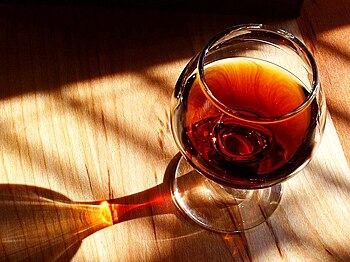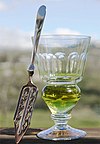Portal:Drink
The Drink Portal
A portal dedicated to all beverages
Introduction

A drink or beverage is a liquid intended for human consumption. In addition to their basic function of satisfying thirst, drinks play important roles in human culture. Common types of drinks include plain drinking water, milk, juice, smoothies and soft drinks. Traditionally warm beverages include coffee, tea, and hot chocolate. Caffeinated drinks that contain the stimulant caffeine have a long history.
In addition, alcoholic drinks such as wine, beer, and liquor, which contain the drug ethanol, have been part of human culture for more than 8,000 years. Non-alcoholic drinks often signify drinks that would normally contain alcohol, such as beer, wine and cocktails, but are made with a sufficiently low concentration of alcohol by volume. The category includes drinks that have undergone an alcohol removal process such as non-alcoholic beers and de-alcoholized wines. (Full article...)
Selected article -

While café may refer to a coffeehouse, the term "café" can also refer to a diner, British café (also colloquially called a "caff"), "greasy spoon" (a small and inexpensive restaurant), transport café, teahouse or tea room, or other casual eating and drinking place. A coffeehouse may share some of the same characteristics of a bar or restaurant, but it is different from a cafeteria. Many coffeehouses in West Asia offer shisha (actually called nargile in Levantine Arabic, Greek, and Turkish), flavored tobacco smoked through a hookah. An espresso bar is a type of coffeehouse that specializes in serving espresso and espresso-based drinks.
From a cultural standpoint, coffeehouses largely serve as centers of social interaction: a coffeehouse provides patrons with a place to congregate, talk, read, write, entertain one another, or pass the time, whether individually or in small groups. A coffeehouse can serve as an informal club for its regular members. As early as the 1950s Beatnik era and the 1960s folk music scene, coffeehouses have hosted singer-songwriter performances, typically in the evening. (Full article...)
Did you know? -
- ... that the relatively low standards of player selection for Somerset County Cricket Club in 1883 have been described as being "determined with a nod and a wink over drinks"?
- ... that Phil Elverum recorded Don't Wake Me Up nocturnally, while "drinking pots of black tea all night"?
- ... that Al-Rantisi Hospital can extract drinking water from air?
- ... that an image of MacCarthy's Bar on the front cover of a book featured a staff member posing as a nun drinking a pint of Guinness and the surprise appearance of a dog?
- ... that the Buddha is said to have sat under a charoli tree at Bodh Gaya for seven days without eating, drinking, washing, excreting, or lying down?
- ... that the John Snow pub is named for a shy British epidemiologist who did not drink?
General images -
Selected image -

Selected biography -

Amund Ringnes (7 October 1840 – 13 January 1907) was a Norwegian businessman, brewery owner and patron.
He was born in Krødsherad, Buskerud, the son of Anders Knudsen Ringnes (1813–75), farmer, and his wife Maren Amundsdatter (1815–76). He grew up at the Ringnes farm, and commenced working at Akers Mekaniske Verksted in 1860. He left Akers Mek. Verksted in 1865, and was employed by the brewery Christiania Bryggeri. In 1876, he founded Ringnes & Compani brewery with his brother Ellef Ringnes and the businessman Axel Heiberg. It was the eighth brewery in Christiania (now Oslo), and later had its name changed to Ringnes Bryggeri. (Full article...)Selected quote -
| “ | I want one bourbon, one scotch and one beer
One bourbon, one scotch, one beer. |
” |
| — John Lee Hooker George Thorogood & The Destroyers (1977) |
Selected ingredient -

Carrageenans or carrageenins (/ˌkærəˈɡiːnənz/ KARR-ə-GHEE-nənz; from Irish carraigín 'little rock') are a family of natural linear sulfated polysaccharides that are extracted from red edible seaweeds. Carrageenans are widely used in the food industry, for their gelling, thickening, and stabilizing properties. Their main application is in dairy and meat products, due to their strong binding to food proteins. In recent years, carrageenans have emerged as a promising candidate in tissue engineering and regenerative medicine applications as they resemble native glycosaminoglycans (GAGs). They have been mainly used for tissue engineering, wound coverage, and drug delivery.
Carrageenans contain 15–40% ester-sulfate content, which makes them anionic polysaccharides. They can be mainly categorized into three different classes based on their sulfate content. Kappa-carrageenan has one sulfate group per disaccharide, iota-carrageenan has two, and lambda-carrageenan has three.
A common red seaweed used for manufacturing the hydrophilic colloids to produce carrageenan is Chondrus crispus (Irish moss), which is a dark red parsley-like alga that grows attached to rocks. Gelatinous extracts of the Chondrus crispus seaweed have been used as food additives since approximately the fifteenth century. Carrageenan is a vegetarian and vegan alternative to gelatin in some applications, so may be used to replace gelatin in confectionery and other food. There is no clinical evidence for carrageenan as an unsafe food ingredient, mainly because its fate after digestion is inadequately determined.
The first industrial scale commercial cultivation of Eucheuma and Kappaphycus spp. for carrageenan was developed in the Philippines. The global top producers of carrageenan are the Philippines and Indonesia. Carrageenan, along with agar, are used to produce traditional jelly desserts in the Philippines called gulaman. (Full article...)Topics
| General topics: | Bartending • Bottling • Drinking • Drinking water • Bottled water • Mineral water • Coffee • Energy drink • Juice • Tea • Milk • Plant milk • Pasteurization • Refrigeration • Steeping • Water purification |
| Alcoholic beverages: | Beer • Brandy • Brewing • Caffeinated alcoholic drinks • Cider • Cocktails • Distillation • Fermentation • Hard soda • Liquor • Liqueur • Malt drink • Mead • Proof • Rice Wine • Schnapps • Vodka • Whiskey • Wine |
| Soft Drinks: | Carbonation • Cola • Orange soft drink • Frozen carbonated drink • Root beer • Soda water • Lithia water • |
| Miscellaneous: | Drink industry • Lemonade • Limeade • Orange drink • Slush (beverage) |
List articles
Subcategories
Related portals
WikiProjects


WikiProject Food & Drink is an association of Wikipedians with an interest in culinary-related subjects. They have come together to co-ordinate the development of food and drink articles here on Wikipedia as well as the many subjects related to food such as foodservice, catering and restaurants. If you wish to learn more about these subjects as well as get involved, please visit the project.
 WikiProject Beer – covers Wikipedia's coverage of beer and breweries and microbreweries
WikiProject Beer – covers Wikipedia's coverage of beer and breweries and microbreweries
![]() WikiProject Wine – aims to compile thorough and accurate information on different vineyards, wineries and varieties of wines, including but not limited to their qualities, origins, and uses.
WikiProject Wine – aims to compile thorough and accurate information on different vineyards, wineries and varieties of wines, including but not limited to their qualities, origins, and uses.
| Child projects: | Task forces: (All inactive) |
| Related projects: | |
Things you can do
 |
Here are some tasks awaiting attention:
|
Associated Wikimedia
The following Wikimedia Foundation sister projects provide more on this subject:
-
Commons
Free media repository -
Wikibooks
Free textbooks and manuals -
Wikidata
Free knowledge base -
Wikinews
Free-content news -
Wikiquote
Collection of quotations -
Wikisource
Free-content library -
Wikiversity
Free learning tools -
Wiktionary
Dictionary and thesaurus






































































